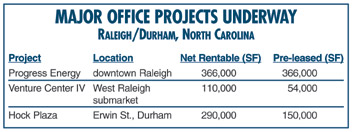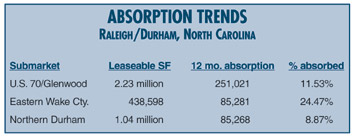|
SOUTHEAST SNAPSHOT, AUGUST 2004
Raleigh/Durham Office Market
 |
|
Gary Lyons, CCIM
Senior Advisor
Sperry Van Ness/AIM Realty Advisors
|
|
Office development in Raleigh/ Durham, North Carolina, is
beginning to pick up as office absorption improves. “However,
as a result of the tremendous run-up in vacancies that began
in 2001, office development is still far below the past 10-year
average,” notes Gary Lyons, senior advisor with Sperry
Van Ness/AIM Realty Advisors. As of the end of 2003, the area
only had three major office projects underway: Progress Energy,
Venture Center IV and Hock Plaza (please see chart at right
for more information).
From an absorption perspective, there are three submarkets
that have rebounded — U.S. 70/Glenwood, Eastern Wake
County and northern Durham. In the past 12 months we have
seen the following changes in the U.S. 70/Glenwood, Eastern
Wake County and Northern Durham submarkets (please see chart
at right for more information).
In contrast, over the past 12 months, Cary gave back 117,680
square feet (2.61 percent), the Research Triangle Park (RTP)/Interstate
40 corridor gave back 611,507 square feet (6.88 percent) and
central Durham gave back 82,487 square feet (5.58 percent).
“The Progress Energy building, which is under construction
in downtown Raleigh, is part of a much larger redevelopment
of significant portions of our central business district,”
says Lyons. “We are seeing a revitalization of the downtown
core with the redevelopment of the old Belk building and discussion
regarding the construction of a new five-star hotel and convention
center.”

There is no single concentrated area of office development.
“Because of the excess supply that has accumulated over
the past 3 years, we are seeing very little speculative construction,”
Lyons comments.
Most of the construction is build-to-suit-related activity
as a result of successful pre-leasing. The Raleigh CBD is
active as are portions of the I-40/Highway 55 corridor near
RTP in Durham as well as near Duke University in Durham (additional
medical space). In general, the projects are much smaller
than they were in the late 1990s when many large Class A office
buildings were put up.
Class A rents range from $16.50 to $23.50 per square foot;
however, the vast majority are between $18 and $20 per square
foot.
At the end of 2003, Class A vacancies ranged from a low
of 6.3 percent in downtown Raleigh to a high of 24.7 percent
in Cary. The RTP/I-40 corridor, which had been one of the
strongest markets in the ’90s, was a close second in
vacancy at 23.4 percent. Most submarkets, however, were between
10 and 16 percent.

“The Interstate 540 corridor around Glenwood Avenue near
the Raleigh-Durham International Airport (RDU) should be a
very good one for office development,” says Lyons. “I
can envision significant office space beginning to develop
around the Briar Creek planned-unit development (PUD) near
RDU and RTP, as well as Wakefield in north Raleigh near Wake
Forest. Both of these PUDs have been highly successful in
terms of roof top additions and retail development. The CBD
should continue to experience steady development since it
is the tightest submarket.”
The RDU office market was hit harder during the recent recession
than at any time during the past 20 years. Many factors came
into play, but the single biggest impact came from the implosion
of the high-tech sector. Raleigh/Durham shed tens of thousands
of jobs at AT&T, Nortel, IBM, Lucent, Alcatel and even
Cisco. In fact, Cisco has five or six large office buildings
sitting vacant, just waiting for an upturn in the company’s
hiring.
©2004 France Publications, Inc. Duplication
or reproduction of this article not permitted without authorization
from France Publications, Inc. For information on reprints
of this article contact Barbara
Sherer at (630) 554-6054.
|
